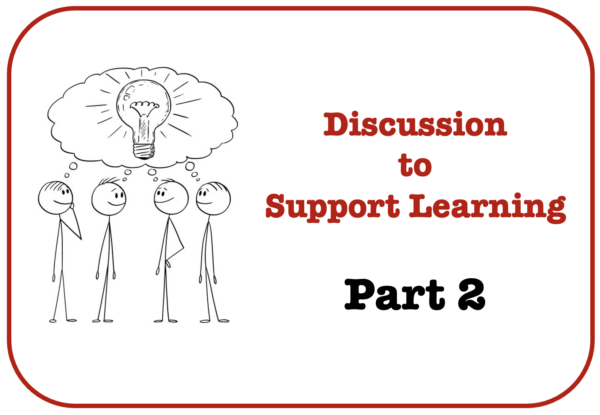Discussion to Support Learning, Part 2

This is the second of a three-part series of posts focused on using discussion to support learning. Part 1 introduced how discussion supports learning, especially discussion based on text. Part 1 also reviewed the research supporting classroom discussion, described formats, and offered instructional suggestions.
Planning Discussions
Besides identifying the content and text that will be the focus of a discussion, the teacher should develop goals for the discussion and explain them to students. This includes considering what the students should be able to do during the discussion, such as explain what they learned from the text, critique the text, make a connection to another text, or agree/disagree with the author’s position in an argumentative text.
Questions to consider while planning discussions:
- What are the main ideas and essential concepts I want my students to learn?
- What are my goals for the discussion?
- Which discussion format(s) and activities will best support my goals?
- What are the best initial and follow-up questions to drive an effective discussion?
- What can I plan ahead of time to ensure that all students participate and stay engaged throughout the discussion?
- What tasks should I have students complete before the discussion that will prepare and enable them to participate in the discussion?
Preparing Questions
Questions are an important part of high-quality discussions. They are used to begin and sustain a discussion and will help the teacher anticipate and prepare for how a discussion may evolve.
Productive discussions typically revolve around a series of well-thought-out, open-ended questions (sometimes called interpretive questions) that push students to think more critically. These kinds of questions have no pre-specified answers and are not simply answered with yes or no. They are designed to spark multiple positions and perspectives by students. Productive discussions include questions that “prompt the students to make connections to their own lives or feelings (affective response questions), to other texts or media (intertextual response questions), and to knowledge or understanding established by the group (shared-knowledge response questions)” (Wilkerson et al., 2015 p. 37).
Teachers should keep in mind the need to be flexible about the order they pose planned questions and that not all questions may be used depending on how the discussion unfolds.
Once students share responses to an initial question, the teacher asks follow-up questions, building on those responses with questions that incorporate what students said (called uptake). The initial and follow-up questions should afford students control over the flow of the discussion with the teacher as facilitator. (Wilkerson et al., 2015)
The research guide Improving Adolescent Literacy: Effective Classroom and Intervention Practices (Kamil et al., 2008) notes that questions that lead to good discussions are frequently described as “authentic” in that they ask a real question that may be open to multiple points of view, such as “Did the way ____ treat ____ in this story seem fair to you?” or “What is the author trying to say here?” or “How does that information connect with what the author wrote before?” These kinds of questions provide an opportunity for exploration and discussion and are very different from questions primarily used to test students’ knowledge.
After Questions
Students benefit from the opportunity to debrief after a discussion. The following questions can help students continue to build on what they learned during a discussion and reflect on how to improve their participation in future discussions.
- What are the most important ideas or concepts we addressed during our discussion?
- Do we have any questions about these ideas or concepts?
- How can we summarize our discussion?
- How do we feel the discussion went?
- What was the most effective part of our discussion?
Teaching Collaboration, Discussion Norms
Students may not participate in discussions if they feel their comments are not valued or are ignored, so teachers should establish discussion norms to support safe spaces for students to participate in discussions. Time should be provided to talk about the importance of norms with students, and the norms should be reviewed before each discussion.
Michaels and O’Connor (2012, p. 2) note the following about discussion norms:
“Students have to feel a sense of trust that their ideas will be taken seriously and that disagreements will be handled respectfully, so that ideas – not individuals – are challenged. Students have to speak loudly enough so that everyone can hear, and all students have to be on notice that if they cannot hear or understand what someone has said, they have to speak up and ask for clarification. Students need to understand that this kind of talk is expected of everyone, and everyone will have a chance to participate and express their ideas, perhaps not in every discussion, but certainly over the course of several days.
Teachers across grades and subjects can use the sample set of norms below.
Discussion Guidelines
- Come Prepared: Complete any pre-reading or assigned tasks to enhance your ability to participate effectively in the discussion.
- Respectful Listening: Listen attentively to others without interrupting. Give your full attention when someone is speaking.
- One Speaker at a Time: Raise your hand or signal when you want to contribute, and wait for the speaker to finish before responding.
- Respect Other Viewpoints: Appreciate and respect different viewpoints, even if they differ from your own. Everyone’s ideas are important.
- Stay on Topic: Keep the conversation focused on the discussion topic. If you have a new point, relate it back to the subject at hand.
- Encourage Participation: Help create an inclusive environment by encouraging everyone to participate. Offer opportunities for quieter classmates to share their thoughts.
- Support Your Ideas: When sharing your opinion, provide reasons or evidence to explain your point of view. Use examples when possible.
- Be Open to Constructive Feedback: Accept and give feedback respectfully, without taking it personally. Critique ideas, not people.
Part 3 of the series will address academically productive talk, including details about the Accountable Talk framework developed by researchers at the University of Pittsburgh. Suggestions for facilitating high-quality discussions will be shared, including teacher and student Talk Moves.
Part 2 References
- Kamil, M.L., Borman, G.D., Dole, J., Kral, C.C., Salinger, T., and Torgesen, J. (2008). Improving adolescent literacy: Effective classroom and intervention practices: A Practical Guide (NCEE #2008-4027). Washington, DC: National Center for Education Evaluation and Regional Assistance, Institute of Education Sciences, U.S. Department of Education.
- Michaels, S. & O’Connor, C. (2012). Talk science primer. Talk Science Project (TERC).
- Wilkinson, I., Murphy, K. and Binici, S. (2015). Dialogue‑intensive pedagogies for promoting reading comprehension: What we know, what we need to know. In: L. Resnick, C. Asterhan and S. Clarke, Ed., Socializing intelligence through academic talk and dialogue. Washington D.C.: American Educational Research Association, pp.37‑50.

 Joan Sedita is the founder of Keys to Literacy and author of the Keys to Literacy professional development programs. She is an experienced educator, nationally recognized speaker and teacher trainer. She has worked for over 35 years in the literacy education field and has presented to thousands of teachers and related professionals at schools, colleges, clinics, and professional conferences.
Joan Sedita is the founder of Keys to Literacy and author of the Keys to Literacy professional development programs. She is an experienced educator, nationally recognized speaker and teacher trainer. She has worked for over 35 years in the literacy education field and has presented to thousands of teachers and related professionals at schools, colleges, clinics, and professional conferences.
I try to practice these guidelines in my classroom as a whole already. It can be difficult when teaching middle schoolers as they just want to comment in the moment and not wait. I think printing the listed guidelines about and talking about each on in detail could really aid in having a cohesive conversation. I think role playing where we show students what each one looks like can be a great incentive as well.
Any Teacher should always be prepared. I always over prepare and rather have to much than not enough. You can then pick and chose depending on the flow of the class.